DRBR 28: How to behave in Shul
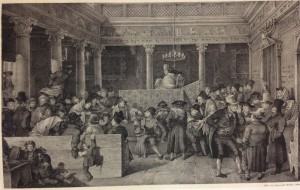
What we have today is a lithograph, Das Innere einer Sinagoge in Rom, or Interior of a Synagogue in Rome; click the image at right to see a larger version. It’s by the Swiss artist Hieronymus Hess, and it’s one of a pair, the Rare Book Room doesn’t have the other half of the pair, but Sothebys had some notes about it. The first half of the pair “portrays a Catholic practice of requiring Jews to listen to conversionist sermons which persisted until well into the 19th century” and they’re all staring into the distance as a preacher harangues them. But in our print they’re on home turf and enjoying themselves.
Hess is famous for social caricature and satire. This piece is certainly that. Open question whether you also want to label it antisemitica, Hess not being Jewish (but he hung out with Nazarenes, so he probably had Ideas about Who Is Doing Religion Right, and it isn’t the Jews, so he’s probably disapproving at the least). Christians quite often get on our case for being insufficiently decorous in shul.
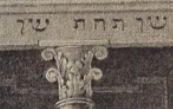
So, we have a synagogue interior, that of the Tempio Italiano in Rome. I thought it very odd indeed that the frieze around the top of the shul has the text of “An eye for an eye;” Vivian Mann says many of the interior details are accurate, but she doesn’t mention this specifically, and it seems more likely to be an anti-semitic comment. We don’t usually put bloodthirsty, vengeful verses on our holy spaces.
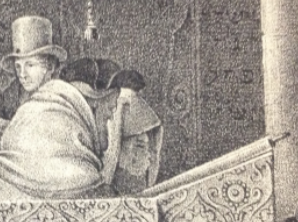
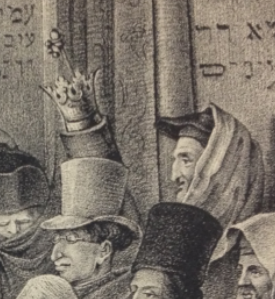
It appears to be Torah-reading time; there’s what looks like a scroll on the bima, one of those very tall scrolls, and another scroll up at the front by the aron with a crown on.
Bear in mind that particular details of such a picture as this are a heavy mix of artist’s impression and fantasy. There’s no guarantee that the Italian Jews read with three persons on the bima. That said, I’m guessing the guy with the top hat gazing off into the distance is the person honoured with the aliyah, because he isn’t paying attention to the reading. The guy whose tallit covers his eyes is the one doing the reading, because it’s practically a rule that the reader has to be so muffled as to be inaudible. And the one with the tricorn hat is the gabbai, who’s actually the one paying attention.

I think this chap is taking snuff.

I do not know why this chap is climbing on the column, tallit flying, but possibly he wants to leap down and deliver retribution on that guy with the flowing white headgear. It doesn’t seem that his problem is being unable to see the activity on the bima.

These guys I am all too familiar with. They’re saying “Can’t they shut up with the damn leyning? We’re trying to learn Torah here!”
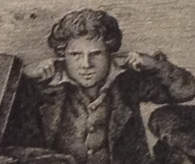
It’s unclear whether this child is responding to the din in the synagogue, or whether he’s an allegorical Jew, equally uninterested in his own religion as the one the kind Christians are trying to give him. Obviously all the Jews here are pretty uninterested in their own religion, but they don’t actually have their fingers in their actual ears. The other two kids in the foreground are a) sleeping b) climbing over the pew back to get away.
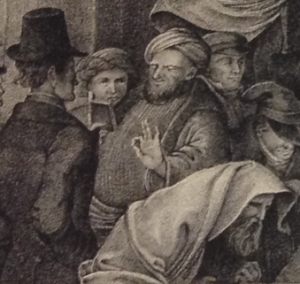
Here we have a very pious chap; you can tell he’s pious because he has mighty moustachios, whereas most of the people in the shul have no beards. And right behind him, juxtaposed, is a big fat guy (Jews are greedy) making a hand-signal which I read as “money” but I might be wrong. Perhaps the book he’s holding is an account book; perhaps it’s the Bible and it’s showing how Jews just twist the Holy Law to get money out of it.

The Tablets of the Law above the ark are divided the Christian way, four and six, not the Jewish way of five and five, the way they actually were in that shul (Evelyn Cohen, Vivian Mann, Gardens and Ghettos, p. 255). This points to the picture being a Christian allegory, and our guy here would be an allusion to the moneychangers in the Temple.
Which I could go on about at some length, but this post is long enough already. Suffice it to say that with the amount of administration the Temple was doing, there’s nothing wrong with having moneychangers there, and it’s only a big deal if you correlate piety with poverty. Which some Jews do and some Christians do, and some Jews don’t and some Christians certainly don’t (see various church schisms throughout the history of the church). But it’s used to show that Jews are venial and given to profaning the holy with their everlasting grubbing for money, which is not nice.
I shall leave you with the impressions of another Christian, Samuel Pepys the diarist, upon visiting the synagogue, not witting that it was Simchat Torah:
But, Lord! to see the disorder, laughing, sporting, and no attention, but confusion in all their service, more like brutes than people knowing the true God, would make a man forswear ever seeing them more and indeed I never did see so much, or could have imagined there had been any religion in the whole world so absurdly performed as this.
Next time, we shall see some examples of Proper Decorum, also featuring a camel.
Mirrored from hasoferet.com.
This entry also appears at http://hatam-soferet.dreamwidth.org/758735.html.
people have commented there, and you're welcome to join them. I've disabled LJ comments for the time being because of excessive spam.